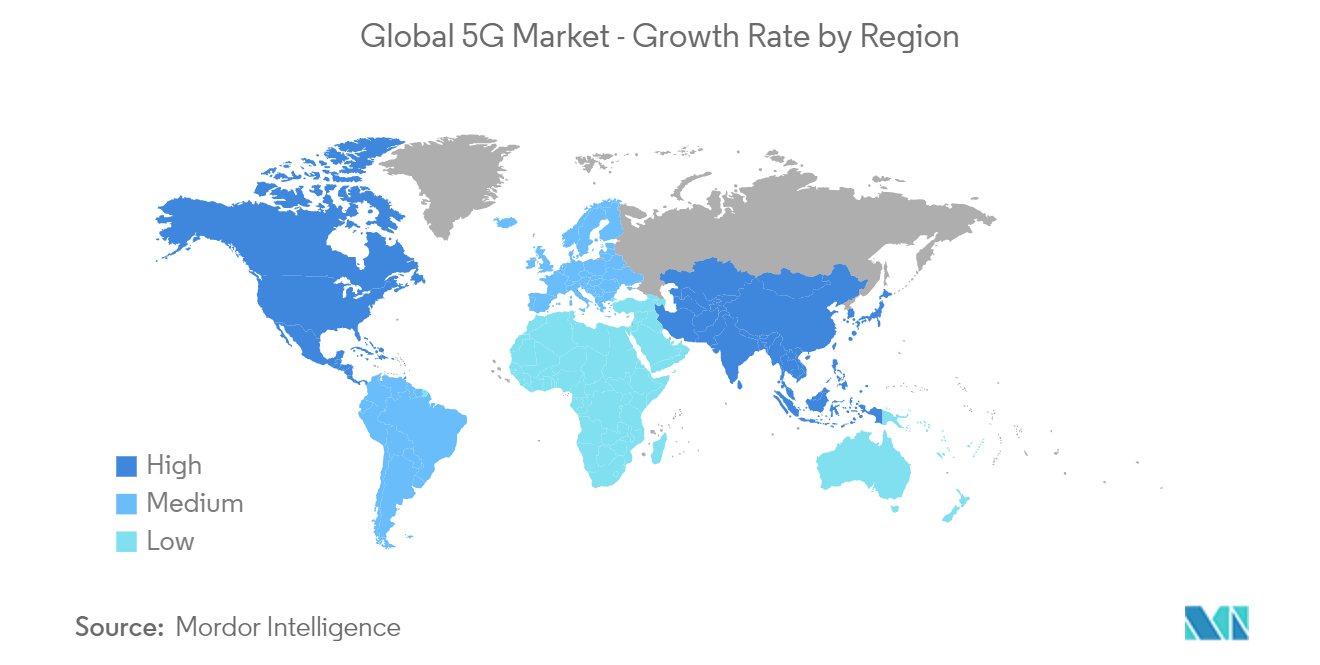Market Trends of Global 5G Industry Landscape
This section covers the major market trends shaping the 5G Market according to our research experts:
5G Devices are One of the Factors Driving the Market
- According to GSMA, a new wave of the 5G rollouts in large economies with modest income levels (such as Brazil, Indonesia, and India) could encourage the mass production of 5G devices that are more accessible to lower-income people. It might also encourage the creation of brand-new 5G business and consumer applications in developing regions, given that most 5G applications and use cases to date have been concentrated on more developed markets. In the meantime, the average retail price of a 5G phone has now dropped below USD 500, with some suppliers, like Realme, offering smartphones for less than USD 150. This encourages 5G uptake in less developed regions and creates an opportunity for cutting-edge services based on the technology.
- Further, according to Ericsson, global 5G subscriptions are anticipated to jump dramatically between 2019 and 2027, from over 12 million to over 4 billion subscriptions. The regions with the most significant anticipated subscription numbers include North East Asia, South East Asia, India, Nepal, and Bhutan. Additionally, the GSMA predicts that by 2025, 5G connections will make up more than half of all mobile connections in the Developed Asia Pacific, North America, and Greater China.
- Moreover, laptop manufacturers are incorporating 5G technology to capture a wide market share. For instance, last year, Intel, a chipmaker, offered the new 5G Solution 5000 modem in laptops from Acer, ASUS, and HP in more than 30 laptop models. Additionally, Intel is enhancing its Tiger Lake series of 5GHz-capable ultra-thin notebooks. The Intel 5G Solution 5000 is an M.2 module that has received certification for global coverage from AT&T and Spring, among other carriers. Intel can provide upload and download speeds of up to 1.25 and 4.7 Gbps, respectively.
- Further, in October this year, Hyundai Mobis claimed to have created a 5G-based communication module for automobiles to enhance the performance of connected car systems, including autonomous driving. This module enables real-time, large-volume data processing. According to the provider, the new module uses ultra-high speed, ultra-low latency, and hyper-connection technologies to combine memory and communication operations, as well as radio frequency circuits and GPS.
- On the contrary, as most of the smartphone companies in the United States rely on a wide range of target audiences for 5G devices, this may affect the consumers' choice to upgrade to 5G. According to the NPD Group, US smartphone users hold on to their smartphones for more extended periods, which has presented a challenge for the smartphone market in the recent past. Manufacturers and carriers are expecting 5G to help reinvigorate the upgrade cycle. However, pricing could present another hurdle.

China Holds Prominent Share of the Market
- China is expected to lead the early deployment of 5G-capable vehicles, apex from strong early support from the domestic government in infrastructure capabilities, advanced research and development from the local supply chain, and consumers' appetite for the upcoming technology inside and outside of the vehicle. The fact that these vehicles will be exclusive to China's large domestic market further streamlines adoption because 5G infrastructure and standards are very likely to be standardized across the territory.
- According to the Government Services and Data Management Bureau of Nanshan District, to support city-level administration and services, Nanshan, a developed administrative region in the first-tier city, adheres to a thorough top-level design plan powered by cutting-edge 5G + technology. The program addresses the majority's most urgent requirements by considering governance, public services, and industry development. A super-large city-level cognitive network with 5G + IoT capability has been developed from terminals to networks. It reshapes the coupling effects of 5G + smart cities by presenting growth trends of the urban 5G sector in a panoramic, layered, and dynamic manner.
- Similarly, according to the Bureau of Emergency Management of Lishui, in Zhejiang Province, Lishui is the prefecture-level city with the most significant land area. The city experiences a variety of calamities that frequently occur and result in substantial losses due to its almost 90% forest coverage, 5% water content, and 5% farm area. A visualization system is essential for making informed decisions, effective command and scheduling, and resolving situations promptly. Based on the demands of the Bureau of Emergency Management for the benefit of people's livelihood, Lishui 5G emergency visualization system is a platform integrating cloud, management, and terminal. The platform offers features like disaster early warning, remote search and rescue, and satellite communication thanks to the 5G network, 5G mobile cabin, and other capabilities.
- Further, in the tropical province of Hainan, a 5G smart healthcare network integrating MEC and AI, developed by China Unicom and Huawei, has increased the efficiency and reach of medical services. Each municipal and county hospital, as well as 340 township health centers and 2693 village clinics, all have telemedicine equipment installed. The network offers remote consultations and diagnosis with AI assistance. Average patient wait times have been cut in half, while medical treatment effectiveness has increased by 30%.
- Moreover, China is also witnessing an upward trend in smart manufacturing plants where M2M communication is crucial to the efficient function of the entire plant. Therefore, the increasing uptake of these technologies by various end-user industries is leading to increased development in 5G connections. For instance, the RoboTechnik plant in Suzhou, Jiangsu Province, is moving towards a complete 5G-enabled smart plant. The prototype plant planned to install a 5G network to replace the fixed lines and Wi-Fi connections at the operational layer to make the equipment more intelligent and facilitate the transformation of the industrial applications to the cloud to achieve flexible and smart manufacturing.


